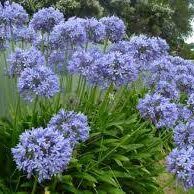Just how to Plant and Maintain Agapanthus in Your Garden
Just how to Plant and Maintain Agapanthus in Your Garden
Blog Article
Grasping the Art of Agapanthus Treatment: Necessary Actions for Healthy Development and Lively Flowers
In the realm of cultivation, the farming of agapanthus stands as a satisfying endeavor for those that seek to support these sophisticated blooming plants. With their striking flowers and graceful vegetation, agapanthus has recorded the attention of garden enthusiasts worldwide. Nevertheless, achieving ideal development and vivid blooms calls for a nuanced technique that includes numerous vital steps. From choosing the best range to understanding pruning strategies, the journey in the direction of cultivating growing agapanthus plants is diverse and holds the key to opening the complete capacity of these agricultural gems.

Picking the Right Agapanthus Variety

When picking the ideal Agapanthus variety for your yard, think about factors such as environment suitability, blossom color, and development practice. In addition, think about the climate in your area to ensure the Agapanthus selection you select can prosper in your particular problems. Recognizing the development habit of various Agapanthus varieties is vital for correct placement within your yard.
Ideal Planting Problems
Thinking about the optimal ecological needs is crucial for successful Agapanthus growing. Agapanthus plants are delicate to cold temperature levels and ought to be secured from frost throughout wintertime months.
To ensure healthy growth and vibrant blooms, plant Agapanthus bulbs at a depth of about 2-4 inches and room them 8-12 inches apart. Mulching around the base of the plants helps keep moisture and suppresses weed growth.
Watering and Feeding Tips
Preserving proper wetness levels and supplying essential nutrients are essential aspects in the treatment regimen for Agapanthus plants. When it comes to watering Agapanthus, it is important to strike an equilibrium. If overwatered, these plants prefer constantly wet dirt yet are at risk to root rot. Throughout the expanding period, water deeply when a week, guaranteeing the soil is well-draining to prevent waterlogging. In hotter environments or during periods of dry spell, even more frequent watering might be needed to keep the dirt equally damp. However, lower watering in the wintertime to avoid waterlogged problems.
Feeding Agapanthus is essential for advertising healthy and balanced growth and prolific blossoms. Apply a well balanced plant food, such as a 10-10-10 formula, in the early spring as brand-new development arises. By complying with these watering and feeding tips, you can ensure your Agapanthus plants prosper and generate dynamic, durable blooms.
Pruning Methods for Agapanthus
Trimming Agapanthus plants at the appropriate times and with appropriate strategies is crucial for preserving their health and wellness and advertising ideal development and blooming. The ideal time to prune Agapanthus remains in late winter or early springtime prior to brand-new development arises. Beginning by read what he said getting rid of any dead or yellowing fallen leaves near the base of the plant. Cut them as short as possible without damaging the emerging shoots.
For flowered stems, wait until the flowers have actually perished and after that cut them back to the base. This not just cleans the plant's appearance but also encourages the growth of brand-new blossom buds. Deadheading spent blossoms can additionally redirect the plant's power right into generating more blooms instead of establishing seeds. Nevertheless, if you intend to collect seeds for propagation, leave some flowers to completely dry and mature on the plant.
Bear in mind to make use of clean, sharp tools to make specific cuts and lower the danger of introducing diseases. Agapanthus. Normal pruning will certainly aid maintain your Agapanthus looking neat and healthy and balanced while guaranteeing a bountiful display screen of lovely flowers
Handling Usual Bugs and Diseases
After making sure proper pruning strategies for Agapanthus, it is vital to address typical pests and illness that can influence the health and vigor of these plants. One usual insect that influences Agapanthus is the Agapanthus gall midge.
One more usual issue is fungal leaf place, which presents as dark lesions on the leaves. To protect against fungal diseases, make sure excellent air circulation around the plants, prevent overhanging watering, and remove any contaminated fallen leaves promptly. Additionally, Agapanthus plants can experience from origin rot if they are grown in poorly draining soil. To avoid this, plant Agapanthus in well-draining dirt and avoid overwatering. By being alert and taking punctual great site activity versus pests and diseases, you can aid your Agapanthus plants grow and create lively blossoms.

Final Thought
In verdict, grasping the art of agapanthus care involves choosing the best variety, providing perfect growing problems, appropriate watering and fertilizing, appropriate trimming techniques, and resolving usual parasites and illness. By adhering to these important steps, you can make sure healthy growth and vivid blossoms for your agapanthus plants. Bear in mind to consistently keep an eye on and maintain your plants to promote their general health and longevity.
To guarantee healthy and balanced growth and vibrant flowers, plant Agapanthus look at these guys light bulbs at a depth of concerning 2-4 inches and space them 8-12 inches apart. By following these watering and fertilizing suggestions, you can ensure your Agapanthus plants grow and produce vivid, resilient blooms.
One typical bug that influences Agapanthus is the Agapanthus gall midget. Furthermore, Agapanthus plants can endure from origin rot if they are grown in badly draining dirt. By complying with these necessary steps, you can make sure healthy and balanced growth and lively blooms for your agapanthus plants.
Report this page